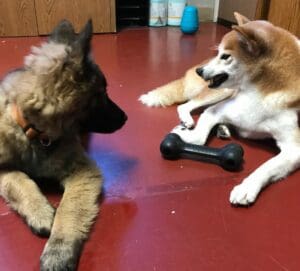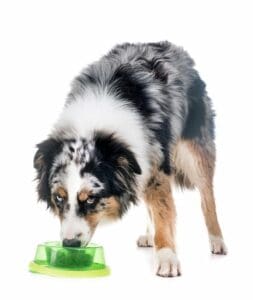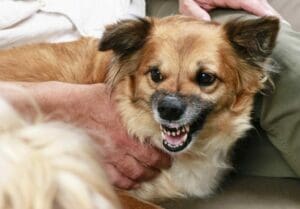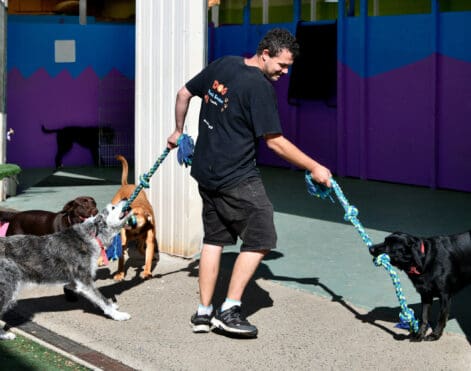Resource Guarding

What is Resource Guarding?
• Resource guarding, happens when your dog shows overly protective behaviour like growling or biting over a resource, or something they consider to be high value.
• A dog’s resource can be anything from food, toys, bed, favourite bone, and even you, their human.

Although it can be tolerable to live with in some cases, severe resource guarding may risk injury and discomfort for both humans and pets. That’s why it’s important to understand what this problem is and how you can take steps to correct it.
Resource guarding actually served an important role in the animal’s evolutionary success. Because dogs are opportunistic feeders, they eat as much as they can when they can, sometimes fending off competition with fierce growls, snarling, nipping, and biting. This can stem from the time they’re young, where the puppy who eats the most (at any cost) grows fastest and strongest, essentially conditioning aggressive behaviours as normal. Also known as food aggression, this type of territorial reaction is under the wider umbrella of resource guarding.
While it is an evolutionary trait, it should be conditioned out of dogs if they’re showing aggression to you or other pets.
It’s important to note that even if your dog displays resource guarding tendencies, you should never assume that he or she is a bad dog. There may be some underlying conditions that are causing your dog’s emotions to flare up.
Causes of Resource Guarding
• Possessive aggression can occur at any point in a dog’s life. The most common way it develops is when breeders feed puppies communally, out of one big vessel, without tending to the weaker and less-aggressive new-borns. The more aggressive puppies get the most food and thus are rewarded for their behaviour.
• It can also develop at any stage of life, particularly if the dog is abused, abandoned, or otherwise mistreated. Throughout their lives, some dogs are in and out of shelters and live in big social groups where they’re forced to compete for territory, food, toys, and even love. If this aggressive behaviour becomes a habit, it can carry over into the home when they’re adopted.
• Finally, a change in behaviour – particularly in older dogs, may mean that there could be an underlying health issue in the pet. Any type of sickness, from distemper to heartworm to kennel cough, can cause the dog stress and lead to over-aggression.
Signs of resource guarding
Although growling, snarling, and biting are obvious signs of aggression, there are some other more subtle ways that your dog may tell you to, “Get back!” In particular, pay attention to body language and audible sounds, and watch for these warning signs:
• Stiffening or rigged stance
• Narrowed-in staring
• Getting in-between object and approaching person/dog
• Always running away with object and refusing to drop
• Rapid eating and chewing
• Showing teeth/curling lips
• Barking
Although these behaviours are troublesome, they occur naturally across all dog breeds. Your particular dog might not have a problem with resource guarding when showing one or two of these behaviours occasionally. However, when many of these warning signs are happening simultaneously and the dog starts physically lashing out, it may be time to reach out for professional assistance.

How to stop your dog’s resource guarding
• A good place to get help would be at your preferred veterinarian’s office, or by consulting an animal behaviourist. They can also help diagnose any underlying medical conditions that could be causing resource guarding.
DESENSITIZE THE DOG BY STANDING OUTSIDE THEIR REACTION ZONE
For canines that are too protective of their possessions, desensitisation is a great approach to help quash it. By cautiously triggering the dog in certain ways, you can help the animal understand they are not under threat.
Stand just outside their “reaction zone”—the area around the item they are resource guarding—while they’re enjoying their prize. The goal is to get them used to the fact that you will not take their food, and reinforce the fact that you’re friend, not foe.
START THROWING THE DOG HIGH-QUALITY TREATS
Feeding high-quality treat will help your pup associate you with generally good feelings of being fed whenever you’re near.
First, stand outside the dog’s reaction zone, and toss the treat in his direction. Once the dog gets comfortable with this, walk slowly toward him and drop the treats directly in front of him.
INCREASE THE INTENSITY BY MOVING CLOSER TO THEIR RESOURCE
The goal of this step is to alter your dog’s emotional response to you coming closer to their possession. Instead of the common reaction of fear or anger at a potential perceived threat, you want the dog to react positively to your presence.
Start far away from the dog while they’re enjoying a treat or mealtime, and slowly approach the reaction zone. Aggressive dogs will let you know when you start to get too close, most likely with a low growl, body stiffening, and/or partial head turn. Stop and wait until the aggressive behaviour subsides, and repeat the process. Doing this helps get you to a point where you can comfortably approach your dog, pet them, and even touch their prize, without triggering aggression.
This is one of the most crucial steps in modifying resource guarding behaviour. As such, it’s important to work consistently and for as long as it takes to be successful. Don’t rush the process. If you manage to have enough patience, you should finally be able to completely take the possession away from your dog without any negative reaction.
LIVE WITH RESOURCE GUARDING
Some pet owners simply live with a dog showing resource guarding behaviours, as long as they’re not causing physical harm or fear. Certain dog lovers have come to expect this type of behaviour, particularly those who have rescued, adopted or otherwise taken in a dog, and just avoid going near them when they have their treasured item. It will depend on your unique situation and lifestyle – a single person could better handle an aggressive dog than a family with infants and toddlers, for example.
Plus, there are other options to mitigate animal aggression, like bringing your dog to its own “safe space” when having guests over or keeping multiple pets separate at mealtime.
RESOURCE GUARDING PREVENTION TIPS
To stop resource guarding before it starts, your best chance is to start prevention measures as early as possible. This is easiest when raising a puppy, but adopted pets should be given the proper attention as soon as they are brought to their forever home. Even dogs that don’t show guarding behaviour should go through some occasional exercises to make sure negative behaviours don’t develop in the future.
When training your dog not to resource guard, it’s important to stay calm, approach an animal slowly, and always have tasty treats on hand. Other things that may help are giving your pup the proper exercise, diet, and veterinary requirements he needs. As long as you follow those practices, you’re ready to stop your dog’s resource guarding.
When it comes down to it, resource guarding can put strain on the human-pet relationship, and you should take the proper preventative measures to make sure everyone stays happy and healthy.
In all, it’s important to understand the many causes, signs, and steps of the process to correct that behaviour as soon as it starts. This way, you’ll have a much more enjoyable pet-owner relationship.






